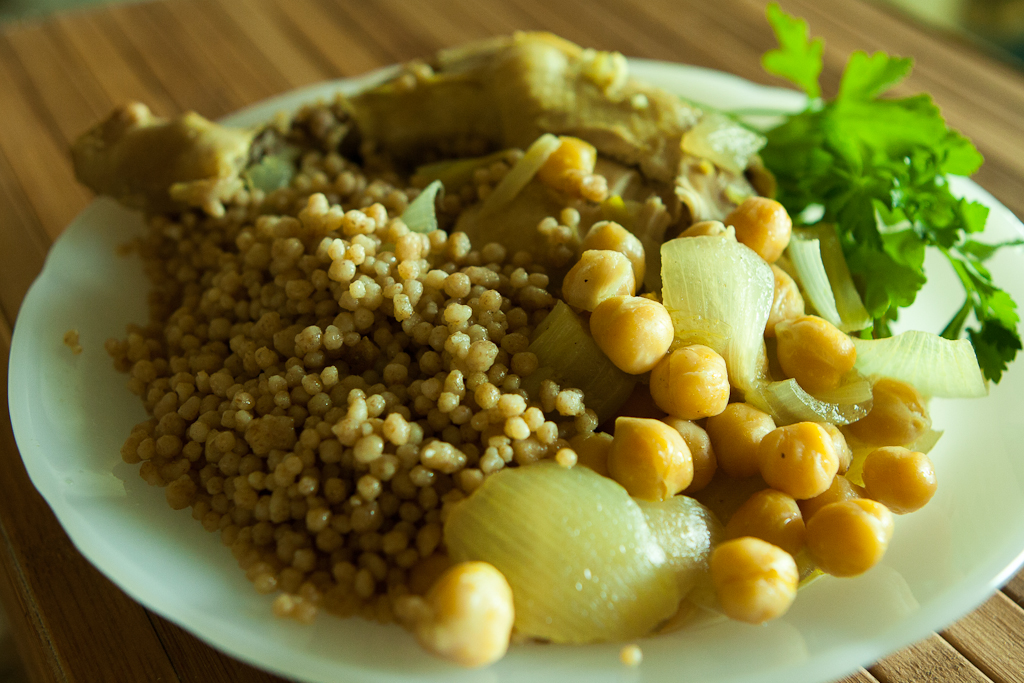Maftoul (Palestinian Couscous) is a Palestinian popular dish, dating back to ancient times, and there are those who say that its origin dates back to the era of the Prophet Solomon, peace be upon him, when the jinn doctor made it for the Prophet Solomon, peace be upon him, to relieve his insomnia.
Maftool finds an area not larger than it for other food in the Palestinian folklore, although there is conflict in the origin of this food and its origin between our East and the Maghreb has no limits, as well as the difference in its name and what its name too, yet it bears a special and close connection with the Palestinian folklore.
The names of this popular food vary; It varies and differs from one country to another in some of what is added to it, although the collective name for it in the Middle East is “Maftoul” and “couscous” in the Maghreb. Several names were given to it in the Arab East, including Babhthoun, Kisa Barr, Mara`oon, Basbson, Kisikson, Dheerjeh, and Al-Maghrebiya. And couscous in Arabic is “flour couscous,” meaning that it is spun and made into fine pieces and grains. The couscous was twisted and any rubbed and whole. Maftool does not belong to one season without another, even if it is overpowered by the fact that it is eaten in the winter and cooked during the coldest days, until they said about the days of snow: “Today is a maftoul day,” where a person stays at home because of the severe cold. In this atmosphere, there is plenty of time to stir the crushed wheat and cook the habathoon. Maftool is associated with winter because it is creamy and protective and provides its eater with warmth and satiety. Maftoul is only eaten in the family, as “the blessing is in the hands”, and it is cooked only when desired, and it is mostly cooked at the beginning of winter, and in the days of olives, and in the “forget of the dead”, and in the month of Ramadan, and on Friday, and some villages in Palestine used to serve it as lunch in weddings. Wheat is considered the main component of the maftoul. Women grind the wheat until it turns into semolina/bulgur, which is placed in a copper bowl and sprinkled with flour and a little water. It is twisted by hand and stirred until it forms small balls. The very small and soft maftoul is sprinkled with sugar and given to the children to eat as dessert and breakfast.

Maftoul (Palestinian Couscous)
Ingredients
- 1 large boiled chicken
- 1 lb of maftoul
- 3 heads of onions diced + 1 small onion
- 1 cup of chickpeas
- 2 cups of tomato juice
- 2 tablespoons of tomato paste
- 1 cup of olive oil
- Half a cup of corn oil
- 3 cups of chicken broth
- 1 and a half tablespoons of salt
- 1 tablespoon of ground caraway
- 1 teaspoon of black pepper
- 1 tablespoon of mixed all spice
- 1/2 teaspoon of cumin
Instructions
- For the chicken preparation
- Season the boiled chicken with (olive oil, caraway, salt, black pepper, mixed spice
- Put it in the oven until it turns red
- For the Maftoul Preparation
- Mix the maftoul with each of (olive oil, a teaspoon of salt, a small onion cut into cubes, mixed spice, caraway, black pepper
- Boil it over the steam by placing it in a colander over a pot on the fire with water and cover it until it is cooked for about 20 minutes
- Prepare the sauce:
- Heat the corn oil in a saucepan, add the onion and sauté until it wilts
- Add the tomato juice and stir a little until it changes color
- Add the chicken broth, chickpeas, tomato molasses and stir
- Finally, add the following spices (1 tablespoon of salt, caraway, mixed spice, cumin, black pepper, to taste
- Cook the sauce on the heat until boiling for about 20 to 25 minutes
- Put the cooked maftool in a serving dish and put the chicken on top, then decorate it with chopped parsley y and serve the sauce in another dish next to it
- Enjoy your dish!





